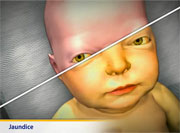
Biliary Atresia
What is biliary atresia?
Biliary atresia is a rare disease that affects infants soon after birth. This disease destroys the ducts that carry bile from the liver to the small intestine. Bile is a yellow-green fluid made in the liver and stored in the gallbladder. Bile helps the body digest and absorb dietary fats and fat-soluble vitamins. If the ducts cannot carry bile, the liver stops working. If this disease is not treated, children may not live more than 2 years.
How does it occur?
The cause of biliary atresia is unknown. It is not contagious, so it cannot be passed from one child to another. Some researchers feel that the bile ducts are not formed properly during pregnancy. Others feel that it begins after birth and may be caused by a viral infection or by a problem with the body's immune system. Biliary atresia is usually diagnosed during the first 2 months of life.
What are the symptoms?
Common symptoms are:
- yellowing of the skin and eyes (jaundice) after 2 weeks of age that does not resolve by 4 weeks of age
- dark urine
- pale, clay-colored stools
- enlarged liver or swollen abdomen.
How is it diagnosed?
Since the symptoms of biliary atresia may also be signs of other diseases, several tests are needed to make a diagnosis:
- blood and urine tests
- stool samples are analyzed
- ultrasound of the liver and bile ducts
- a liver scan showing the liver and bile ducts
- a liver biopsy.
How is it treated?
To treat this disease, bile flow must be restored. This helps prevent further liver damage that could cause liver failure. The most common treatment is an operation called the Kasai procedure. It is named after the surgeon who developed it. The surgeon removes the damaged ducts outside of the liver and replaces them with a piece of the baby's own intestine. This new duct allows bile to drain from the liver into the intestine.
After this procedure, babies usually stay in the hospital for 7 to 10 days. Antibiotics are given to reduce the risk of infection. Medicines are also given to prevent fluid build-up in the abdomen (ascites).
Sometimes this procedure does not work, usually because the blocked bile ducts are inside the liver as well as outside the liver. In this case, a liver transplant must be done. Nearly half of all infants who have had a Kasai procedure need a liver transplant before age 5. Almost all children who have biliary atresia will need to have a liver transplant before they are 20 years old.
Last modified: 2006-05-23
Last reviewed: 2011-03-08

